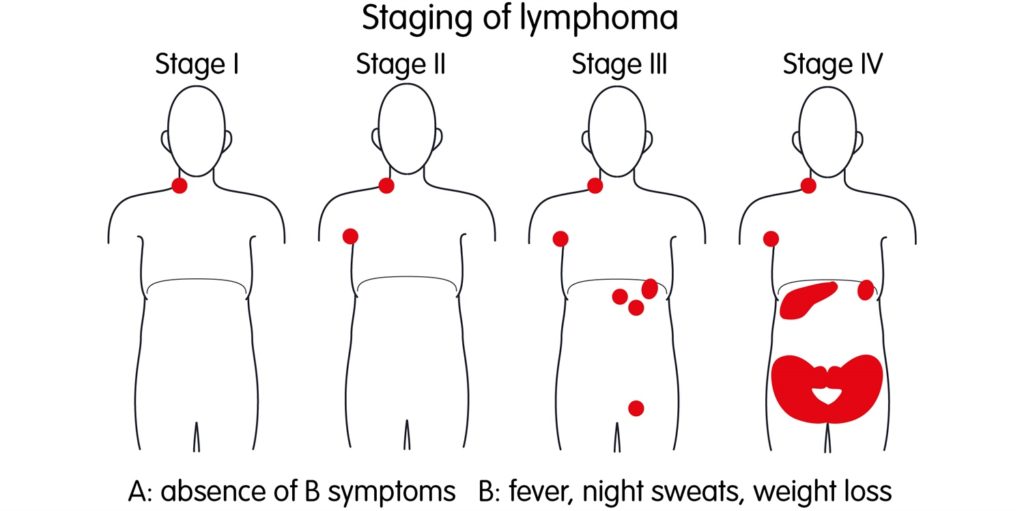Introduction: About Childhood Hodgkin Lymphoma
Childhood Hodgkin lymphoma is a type of cancer that develops in the lymph system, a critical part of the body’s immune system responsible for fighting illness-causing viruses and bacteria. Classical Hodgkin lymphoma is generally characterized by the presence of a particular type of cancer cell known as Reed-Sternberg cells, although a much more rare form of Hodgkin lymphoma known as Nodular lymphocyte-predominant Hodgkin lymphoma is characterized instead by lymphocyte-predominant cells. Childhood Hodgkin lymphoma comprises about 6% of all childhood cancers, and is diagnosed most prevalently in adolescents between the ages of 15-19.
Childhood Hodgkin Lymphoma: Stages
 The “stage” of a disease is a method of determining the extent to which the cancer has grown and spread, and plays a critical role in determining the appropriate course of treatment. Staging childhood Hodgkin lymphoma involves three distinct, yet overlapping, categorizations:
The “stage” of a disease is a method of determining the extent to which the cancer has grown and spread, and plays a critical role in determining the appropriate course of treatment. Staging childhood Hodgkin lymphoma involves three distinct, yet overlapping, categorizations:
A, B, E, and S: Childhood Hodgkin lymphoma is usually described in one of four distinct ways, preliminary to traditional staging:
- A: Diagnosis with no symptoms
- B: Diagnosis with so-called “B” symptoms: fever, weight loss, and/or night sweats
- E: Cancerous cells have been located in an organ or tissue that may be next to, but is not part of the lymph system
- S: Cancerous cells have been found in the spleen
I, II, III, and IV: Specific stages of childhood Hodgkin lymphoma incorporate the A, B, E, and S descriptions:
- Stage I: Cancerous cells are in one or more lymph nodes, but only one lymph node group. Stage IE involves cancer cells outside the lymph system in one other organ or area of the body.
- Stage II: Cancer cells are found in two or more lymph node groups, either above or below the diaphragm. Stage IIE involves cancer cells in one or more lymph node groups above or below the diaphragm and outside the lymph node groups in an adjacent organ.
- Stage III: Cancerous cells are in one or more lymph node groups above and below the diaphragm. Stage IIIE involves cancer in lymph node groups above and below the diaphragm and outside the lymph system in adjacent organs. Stage IIIS includes cancer cells in lymph node groups above and below the diaphragm and in the spleen, while Stage IIIE+S involves cancer in lymph node groups above and below the diaphragm, in nearby organs, and in the spleen.
- Stage IV: Cancerous cells can be found in the lymph nodes throughout one or more organs, as well as in lymph nodes near those organs, or is in one organ and has spread to lymph nodes far away from that organ, or is in the lung, liver, or bone marrow.
Risk groups: Classical childhood Hodgkin lymphoma is also divided into risk groups depending on the bulk of the tumor(s) (“bulky” tumors are defined as 5 centimeters or larger) and whether the patient has so-called “B” symptoms:
- Low risk: Stage I or Stage II with no bulky tumors or “B” symptoms
- Intermediate risk: Stage I or II with bulky tumors OR “B” symptoms; OR Stage III or IV with no “B” symptoms
- High risk: Stage III or IV with “B” symptoms
Childhood Hodgkin Lymphoma: Outcomes and Prognosis
*Disclaimer: Every case of childhood Hodgkin lymphoma is unique and different. Statistics relating to outcomes and prognosis for Hodgkin lymphoma, such as five-year survival rates, are estimates for informational purposes only. If your child has been diagnosed with childhood Hodgkin lymphoma, his or her oncology team will discuss your child’s prognosis in the specific context of your child’s specific disease and medical history.
In general, childhood Hodgkin lymphoma is considered highly “curable”. This particular form of childhood cancer has been found to be very sensitive to both chemotherapy and radiation therapy, and was, in fact, the first form of cancer to be “cured” with radiation therapy alone or with a combination chemotherapy protocol. As with all childhood cancers, however, the five-year survival rate depends upon the unique nature of each child’s specific disease, the stage of the disease upon diagnosis, and the categorization of risk. For children and adolescents with Stage I or Stage II Hodgkin lymphoma, the overall survival rate is over 90%; however, for children and adolescents with Stage III or Stage IV Hodgkin lymphoma, the overall survival rate may be as low as 70%.
Together, we can make a difference.
Donate today because kids can’t fight cancer alone®.
More about Childhood Hodgkin Lymphoma Cancers:
- About Childhood Hodgkin Lymphoma Cancer – Detection and Diagnosis
- Causes, Risk Factors, and Prevention of Childhood Hodgkin Lymphoma Cancer
- What are the signs and symptoms of Childhood Hodgkin Lymphoma Cancer?
- Childhood Hodgkin Lymphoma Cancer Treatment
- What is the expected life span of Childhood Hodgkin Lymphoma Cancer?
- After Treatment – Living as a Childhood Hodgkin Lymphoma Cancer Survivor



